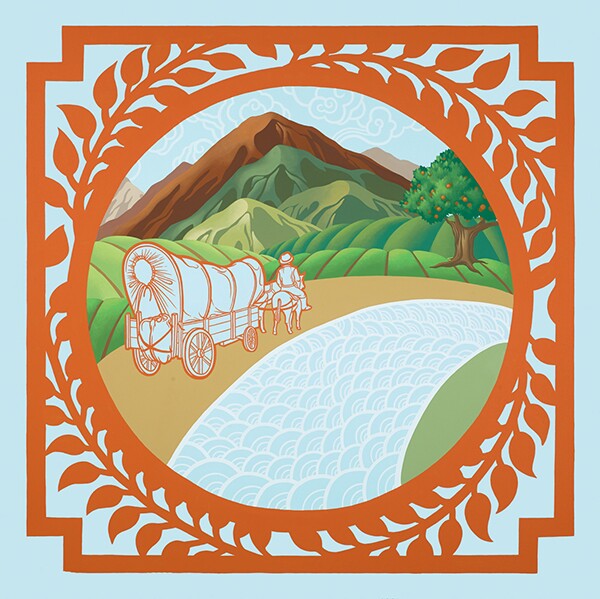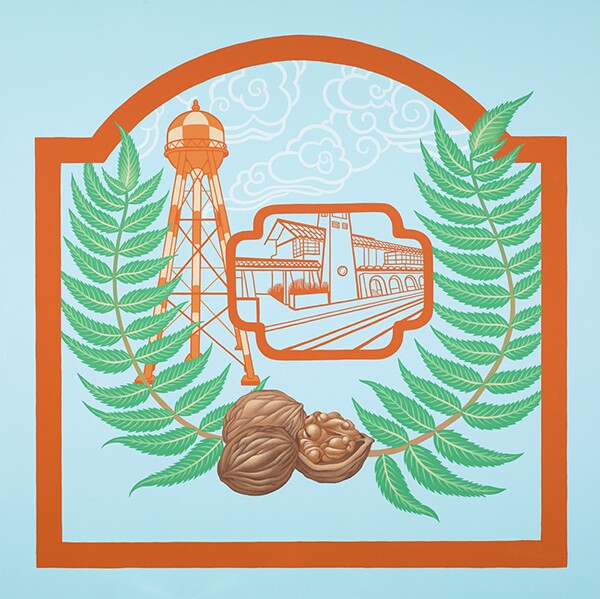Murals at El Monte Station: Phung Huynh

In Partnership with the South El Monte Arts Posse
"East of East" is a series of original essays about people, things, and places in South El Monte and El Monte. The material traces the arrival and departures of ethnic groups, the rise and decline of political movements, the creation of youth cultures, and the use and manipulation of the built environment. These essays challenge us to think about the place of SEM/EM in the history of Los Angeles, California, and Mexico.
_____________________________________________________________
"In the Meadow": An Interview with Phung Huynh
This is the second of four installments in a series of interviews with artists commissioned by Metro to make murals for the renovated El Monte Bus Station.
El Monte: some translate its Spanish name to mean wild scrubland, others to lush meadow. Either way, for much of the first half of the 20th century, El Monte was known as a fertile land where Mexican, Japaneseand Chinese workers lived and labored together among abundant walnut groves and berry fields. With the recent increased growth of the Asian population in El Monte and throughout the San Gabriel Valley, this multicultural history seems as relevant as ever. Artist Phung Huynh honors Asian-Latino cross-cultural exchange in her four-panel mural at the El Monte Bus Station. Huynh is Associate Professor of Art at Los Angeles Valley College and teaches courses in drawing, painting, and design, and has exhibited at Sam Lee Gallery in Los Angeles and Gagosian Gallery in Beverly Hills. Much of Huynh's work explores postcolonial, cross-cultural phenomena.
What is your personal connection to El Monte?
I have a nostalgic connection with El Monte because growing up in high school I would go Chinese school there on the weekends and take my mom's mini van with my cousins there. That's where I learned to read and write Chinese and about Chinese culture. My mom is Vietnamese and my dad is Cambodian, but they were both raised Chinese. So it was very important to them that I learn Chinese too. But for me, El Monte has always been a space for dialogue between Latino and Asian American cultures. I've always felt as much at home in Mexican culture as I do in Chinese, so I wanted to reflect that in the work.
El Monte has not one, but TWO historical museums. You visited both. What role did they play in your research?
I went to the El Monte Historical Society Museum first, and the La Historia Museum. And they are so different. I went to the Historical Society museum and there was this big wagon in the middle and porcelain tea sets showing the Old West kind of thing. I thought, "This is not El Monte!" I think that it doesn't really reflect El Monte and what's going on now, or what I remembered of it. I told the curator, a very friendly woman, why I was there and we were talking about history and then WWII came up. She said that she remembered WWII and the internment of Japanese, and she said that she thought that people exaggerate that part of history. I was so stunned that anyone today, and especially in El Monte, would say something like that. She said that she remembered having Japanese friends and then all of a sudden they were all gone, but she didn't acknowledge that what had happened with the internment camps was wrong. La Historia Society, which is just little ways up the street, was very helpful. Everybody was very helpful. And they have so many great photographs there that people have donated. They had photographs of veterans, men that went off to war and came back and still had to live in segregated communities. That's the history of the people. That's what I wanted to talk about in my work.
You've done several public art projects, in addition to your gallery work. What drives your public art making process, particularly for this mural?
I felt honored to be able to make public art, and as an artist I think you have to be sensitive to the community in making work that's about them and for them. A lot of my work is historically driven. History and culture is very important to me and it's core to this project. Also as an educator, my work is also very important. I teach at Valley Community College and it's so rewarding because I have students that are the first generation in their family to go to college. So as an artist, I feel like it's my responsibility not just to make work, but to find ways to engage community. Working on this project in El Monte really felt that way to me.
Tell us about the historical narratives in each of your panels.
In the first panel, I put the image of the lion and the owl. The lion is part of El Monte's history because of the lion farm that used to exist here in the 1920s and that is now the mascot for El Monte High School. And in Chinese culture, the lion is seen as a kind of guardian outside of palaces. But I made it into a Chinese lion just to connect it more with the Asian community. And the owl is a sacred creature for the Tongva, the original inhabitants of the area.
In the second panel I wanted to reflect some of the cultural demographic and history. I included the pioneer wagon as a nod to that stereotypical story of the West, which there is some of in El Monte. But I also included the river because the San Gabriel River and the Rio Hondo were such an important part of its history and why people came to this area. I did a kind of Asian rendering of the river and I framed it in the Mexican papel picado. But in general, for this panel I did want it to look like the meadow or the garden of Eden as California was described in the 1800s.

El Monte means "meadow," and in my research I remember reading that when the Spaniards were travelling through California El Monte was a resting place for them. Today there's freeways and kind of an urban jungle, but once it was known as this lush paradise.
In the third panel I included the water tower that many people identify as iconic to El Monte, as well as the Aquatic Center which has produced many accomplished swimmers and continues to be an important part of the community. Both of these harken back to the original importance of water with the rivers flowing through the area. I also included the walnuts in the image because in my readings I found that there were a lot of walnut groves and large walnut industry in the area.

In the last panel, I was acknowledging the farmers and veterans that were both Latino and Asian and both lived in El Monte. Not only did they work together, but they also went off and fought in war together, yet neither are recognized as being an important part of American history. At the bottom I included some images of birds, because not only are they everywhere here in Southern California, but also because they carry cross-cultural meanings. In general, birds are symbols of hope, they are messengers of hope, which is also something that these farmers and veterans shared in common.
Stylistically, how did you find ways to combine Asian and Latino traditions in the mural panels? What other cultural aspects do you see both groups sharing in common?
Both cultures share a beautiful paper cutting tradition. I thought of the panels as flat images hanging high above in the station, and I really liked thinking of the papel picado as a flat piece of paper, so it has the same kind of feeling hanging up there. Formally they are the same type of work in both cultures; I think both share very graphic qualities.
There's so much that is shared in common between Asians and Latinos. We both value extended families, we both use parks and public space similarly for family reunions and other celebrations. Also, we're both pretty matriarchal even though people think that we're both very macho cultures. Finally, Asian and Latino families are very resourceful and we are very hard-working.
Is there a larger narrative that you're telling collectively with all four panels?
Going to La Historia really affected how I made this mural and in how I chose to tell the story of "other." It's a side of American history that is not in our text books. This project became more of a social commentary on history, and how the dialogue of Asian American and Mexican American presence is not just in El Monte, but also nationwide. La Historia also has stories about indigenous people and the barrios and how they evolved with time. I really do hope that one day La Historia will be able to get a more physical presence with a larger building, because they are archiving things that should be known and read.